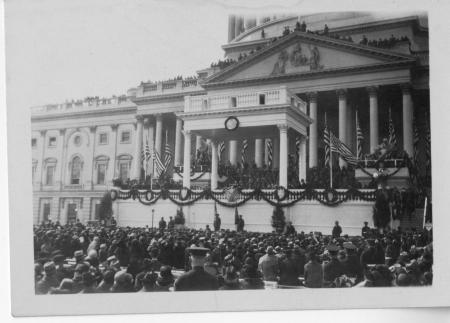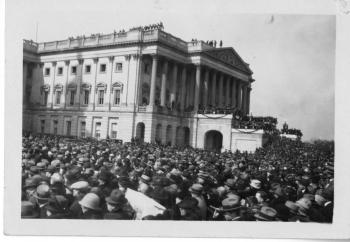 The first time a U.S. President took the oath of office in Washington, D.C., it was March 4, 1801. Thomas Jefferson stood in the Senate chamber of the Capitol before elected officials and invited guests. In 1829, Andrew Jackson raised his hand outside on the Capitol’s East Portico, as a crowd of over 20,000 people watched. From then on, an outdoor ceremony accessible to the public became the norm, a tradition broken only by the most extreme weather or emergency. Every four years, inauguration plans have included larger stands, more extravagant festivities, and, with the advent of radio, television, and social media, an expansion of potential audiences.
The first time a U.S. President took the oath of office in Washington, D.C., it was March 4, 1801. Thomas Jefferson stood in the Senate chamber of the Capitol before elected officials and invited guests. In 1829, Andrew Jackson raised his hand outside on the Capitol’s East Portico, as a crowd of over 20,000 people watched. From then on, an outdoor ceremony accessible to the public became the norm, a tradition broken only by the most extreme weather or emergency. Every four years, inauguration plans have included larger stands, more extravagant festivities, and, with the advent of radio, television, and social media, an expansion of potential audiences.
The first inauguration of the 30th President of the United States, John Calvin Coolidge, Jr. (1872-1933), had taken place under unusual circumstances and in one of the most private of settings, his father’s living room. When President Warren G. Harding died suddenly on August 2, 1923, Vice-President Coolidge was in Vermont visiting his family. A simple oath of office was administered by his father, a notary public, and everyone went back to bed. The next day, upon return to Washington, Coolidge was sworn in a second time by a local judge. Given Harding’s death, Coolidge’s accession to the highest office in the land was understandably low-key, with no celebrations.
When Coolidge was elected to a second term, many people assumed that the 1925 inauguration ceremonies would follow tradition, with plenty of pomp, parades, and parties. Coolidge, though, was a modest man, with little taste for frivolity. He refused to have an inaugural ball and limited the size of the official parade, regarding such things as needless expenditures of public funds. The President’s rejection of extravagance enabled the joint Congressional Inaugural Committee to return over $16,000 to the U.S. Treasury, out of $40,000 that had been appropriated for extra security, more viewing stands, and elaborate decorations.
Inauguration Day, March 4, 1925, turned out to be relatively fair and warm. While many visitors and residents were sleeping late, Coolidge took a stroll out of the White House grounds at 7:30 a.m. “To the Secret Service men who were his sole companions during the walk,” the Boston Globe reported, the President remarked “that on every one of the other eight days when he took an oath of office the weather had been at its best ... he hoped it would not break a precedent today.” Coolidge, who had held various elected offices since 1898, then went in to consume his usual breakfast of buckwheat cakes, maple syrup, and sausage, and took care of correspondence at his desk before departing for the Capitol with first lady Grace Coolidge.
 Coolidge may have shied away from attention but, thanks to new communications technologies, the “attendance” at his 1925 inauguration turned out to be far larger than for any previous ceremony. As former President William Howard Taft (by then Chief Justice of the Supreme Court) administered the oath of office, tens of millions of Americans listened via radio. It was the first time that stations had attempted such ambitious coverage of a live event, transmitting the signal over AT&T telephone wires. Color commentary was provided by Graham McNamee of local station WEAF. Schoolchildren in California listened in their classrooms.
Coolidge may have shied away from attention but, thanks to new communications technologies, the “attendance” at his 1925 inauguration turned out to be far larger than for any previous ceremony. As former President William Howard Taft (by then Chief Justice of the Supreme Court) administered the oath of office, tens of millions of Americans listened via radio. It was the first time that stations had attempted such ambitious coverage of a live event, transmitting the signal over AT&T telephone wires. Color commentary was provided by Graham McNamee of local station WEAF. Schoolchildren in California listened in their classrooms.
Arrangements were also made to transmit photographs of the ceremony via wire. Images sent simultaneously from Washington took seven minutes to arrive in New York and Chicago and “about an hour” to reach the Los Angles Times, marking what that paper trumpeted as a “great step forward” in visual news coverage. The Bell Laboratory engineers who had been working on the process declared it a success.
Still, there is nothing like being present at an event and preserving your own record. Science Service journalist Watson Davis had been born and raised in the Capitol Hill neighborhood, so he knew just where to stand in order to snap two photographs of the Coolidge ceremony. The clouds broke, the sun came out, the crowds cheered, and then Watson, like the conscientious Coolidge, undoubtedly went back to work.
Related Resources
The Oval Office meets the Castle: Presidents at the Smithsonian, The Bigger Picture, Smithsonian Institution Archives
Why the Chicken Really Crossed the Road: An Inaugural Tale, Smithsonian Collections Blog
Produced by the Smithsonian Institution Archives. For copyright questions, please see the Terms of Use.

Leave a Comment